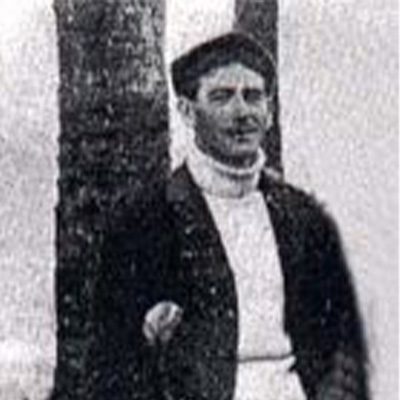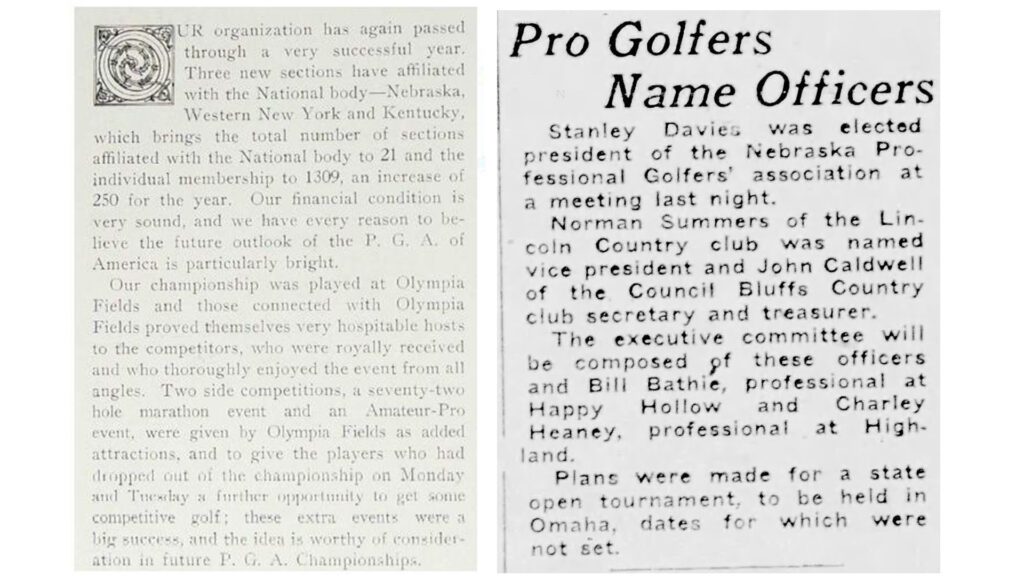
Nebraska Section’s Pioneers Introduced Golf from the Ground Up
Written by Stu Pospisil | Omaha World Herald Reporter & Lead Writer
Charley Johnston was like the other “golf experts” who fostered the game in Nebraska.
They were Scottish- or English-born, apprentices from golf courses of the auld sod.
But of all the golf professionals who predate the founding of the Nebraska Section of the PGA in 1925, Johnston was the best combination of the Pied Piper and Johnny Appleseed.
He banged the drum for golf in the state. He brought the game to new places in the state.
With Johnston, it was written in 1926 when he was about to leave Omaha after 19 years, “The ancient and royal game has grown and prospered in Omaha and Nebraska, far beyond the expectations of the fearless pioneers who planted it here.
“It has grown under Johnston’s eyes and partly under his hands, from something very small and unimportant to something so big that scores upon scores of courses for it have been carved out of what used to be Nebraska pasture and timber land, something played and enjoyed by thousands of Nebraska men and women, something which is called in Nebraska as well as in all America, the greatest summer game.”
Johnston was the architect for more than 20 courses in the Nebraska Section footprint. Parts of today’s Riverside Golf Club in Grand Island, Fremont Golf Club, Norfolk Country Club, River’s Edge in North Platte, Elmwood Park in Omaha and York Country Club remain from his original designs.
It could be hazardous work. When he was surveying the land for the Antelope Park municipal course in Lincoln, the predecessor to the Jim Ager course, Johnston was startled by the whizzing of a bullet passing near him.
Johnston (1862-1937) came to America from Prestwick, Scotland, the birthplace of the Open Championship. He was born between Prestwick and Troon, grew up around those historic courses. Among his associates were Harry Vardon, Willie Park Jr. and J.H. Taylor.
Omaha’s Happy Hollow Club, which started in 1907 on the outskirts of the village of Dundee, hired Johnston in 1908. He had been at Brunswick, Georgia, the previous season after five years at the Milwaukee Country Club.
Johnston stayed at Happy Hollow, which has been replaced by the city’s Memorial Park, for 12 years. His last seven years in Nebraska were at Omaha Country Club. He oversaw construction of the club’s northern Omaha course that replaced the original in the Benson neighborhood.
His last week in Omaha, in 1926, was typical for the pros of the day. He assisted Lakewood Country Club in Ralston, where Johnny Goodman had his first club membership, for the Nebraska women’s state tournament.
The state’s first golf professional was Bob Taylor (1878-1953), hired by the new Omaha Country Club – the first such club in Nebraska –in spring 1900 from the Onwenstia Club and the Glen View Club of suburban Chicago.
“‛Bobby Taylor, the greenskeeper and resident instructor, has found his hands more than full with the host of aspirants for golf perfection and has been obliged to send for an assistant instructor who will arrive within a few days. ‛Prof’ Taylor’s time is taken up several weeks in advance,’’ the Omaha Bee reported in May 1900.
The dual role of golf professional and greenskeeper was common in the early years.
Taylor left OCC for the Minikahda Club in Minneapolis, where he laid out its back nine in 1906 and stayed for 45 years.
The roll of the state’s pioneer golf professionals also included Fred Bartsch, Dave Mentiply, Eugene Reilly, George O. Simpson, William “Willie” Hoare and Jack Shearman at Omaha Country Club, J.M. Watson, W.D. Clark, Stanley Davies, Tom Leuchars and Eddie Murphy at the Field Club of Omaha, James Egan, Norman Summers and Leslie Davies at Country Club of Lincoln, George Dow at South Omaha Country Club, Al Hearn at Hastings, Bobby Christie at Happy Hollow.
Not to mention Johnnie Raeside at Fremont and York, Jimmy Canavan at Fremont, D.H. McKee at Riverside in Grand Island, Billy Ricketts at Norfolk and Art Grosbeck at Beatrice.
Eddie Murphy was one of the youngest professionals ever at a Nebraska Section course. The former Field Club caddie and clubmaker was 17 in October 1918 when he became acting golf professional at the club when Davies, then Leuchars, entered military service at the end of World War I. Murphy held the position for six months until Davies’ return, then was hired by Green Hills Country Club in St. Joseph, Missouri.
Bob Simpson at Omaha Country Club also had a short stay, barely six months in 1907, but he put Nebraska golf on the map with his six-stroke comeback for the Western Open title that June.
Two months later, he resigned. Over a penny gum and candy dispenser.
An innocent swap machine, the kind that retails gum and chocolate in small pieces for one cent per piece, has caused a heap of trouble at the Omaha Country Club.
The resignation of Bob Simpson, golf instructor at the club, its tentative acceptance by E.H. Sprague, chairman of the greens committee, and the signing of a petition by 50 golfers asking that Simpson be retained, are all blamed on the one machine.
Early in the summer the machine was placed near the door of the caddy house for the benefit of the caddies and golfers who might want a piece of gum before starting around the course.
It was liberally patronized, especially by the caddies who soon found a way by which they could extract the pennies from the machine and use them over again.
Naturally, when settling time came, there was a shortage of pennies which could not be explained. Simpson settled in full for the first lot of gum and candy, but refused to stand for the loss in the second lot. – Omaha Daily News
So who was the first member of the Professional Golf Association of America from Nebraska? That honor belongs to Willie Hoare.

William Vincent Hoare
The nation’s fifth club professional, who once hit a gutta percha ball a record 312 yards during the 1899 U.S. Open, Hoare was at Omaha Country Club every golf season from 1915 to 1918. In the winters, he was the professional at Hot Springs (Arkansas) Country Club.
Hoare was among the first 82 PGA members elected on April 10, 1916 – the birthdate of the PGA of America.
Hoare was also the first from Nebraska to serve on the Professional Golfers Association executive board. He represented the wide-ranging Central Section in 1916 and 1917.
The national PGA started with seven Sections in 1916. A reorganization of Sections in 1921 grouped Nebraska with Colorado and Utah.
Four years of inactivity later, the Nebraska Section went on its own in 1925.

About the Nebraska Section PGA
The Nebraska Section PGA is a non-for-profit organization comprised of over 340 PGA Members and PGA Associates who strive to promote the enjoyment and growth of the game of golf. The Nebraska Section PGA encompasses the entire State of Nebraska, western fifth of Iowa and a small portion of South Dakota including Dakota Dunes and Yankton. The Section office is located in Lincoln, NE and acts as a resource for local and national golf information for the golf professional and amateur player alike. Our members are often referred to as “Club Professionals”, not to be mistaken as PGA Tour Professionals.
Each Nebraska Section PGA Professional serves as an expert in the ever-changing business of golf. They are the leading expert players and teachers, skilled business managers, community leaders, and superior merchandisers who have dedicated their careers to the local delivery of these services.